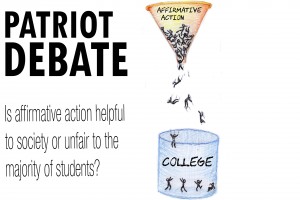Minorities suffer from disadvantages
March 23, 2016
Bewildered in my first week of kindergarten, I raise my hand attempting to tell my teacher that I need to use the restroom. She can’t comprehend my jumbled English and Gujarati, an Indian dialect. I feel ashamed and relieve myself in my pants. I have one of the most embarrassing moments in my life because I didn’t know the word bathroom.
Because my parents are immigrants, I didn’t learn English until my first years of school. Like many other first-generation students, my parents struggled with English, so it was up to me to teach myself the language. We never spoke English at home. Twelve years later, English is still never spoken at my house.
Surely, every American agrees that all legal residents deserve equal opportunity to live the American Dream. By that logic, affirmative action simply makes sense.
According to The Leadership Conference, President Lyndon B. Johnson said in 1965, “You do not take a person who, for years, has been hobbled by chains and liberate him, bring him up to the starting line of a race and then say you are free to compete with all the others, and still just believe that you have been completely fair.”
The chains which Johnson referred to are still hobbling minorities today. Children of immigrants battle adversity by experiencing two cultures simultaneously. Children have parents who struggle with English daily. They have parents that cannot help them with school, even the smallest assignments. They have to be the ones helping their parents instead.
Being put in the situation where you have to write your first essay in second grade and, instead of asking your parents to edit your essay, they ask you to read a portion of a business letter to them is unparalleled. Minorities who experience this deserve and earn having special recognition when applying to colleges and jobs.
Affirmative action extends to more than just minority immigrants, it includes women as well. It gives these students opportunities with colleges and future employers. It allows for their unspoken struggles to be taken into real consideration, struggles that affect minority children every day.
Sure, affirmative action has changed since 1965, but as with every other law, it has adapted sufficiently to meet the needs of the American people.
Affirmative action still functions similarly to how it did in 1965 in its original mission of ending racism. America has grown and become more diverse, but racism is still an issue.
Unfortunately, it will be an issue for years to come. Whether it is the Baltimore riots or stereotyping Muslims as terrorists, racism is still alive today.
Objectively it is true that there is still stereotyping and racism occurring that seems ignored. One example is Riley Cooper using racial slurs towards his Philadelphia Eagles teammates and receiving no punishment.
Acts of racism and ignorance of the adversity minorities face leads directly to the rash judgement of affirmative action as “reverse discrimination.”
Take a walk in a minority’s shoes, remove yourself from the comfort of your prototypical American household with educated parents who have mastered English, and tell me it’s not a whole different world. The day you can successfully live a minority’s life with relative ease will be the day affirmative action will no longer be needed in the greatest nation in the world. Until then, keep your ignorance to yourself.






